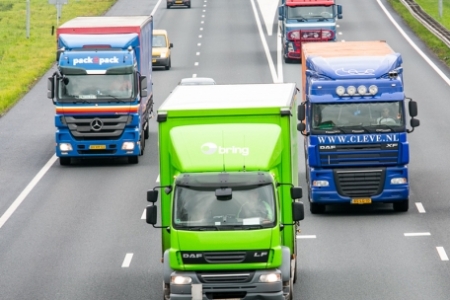Within the European Union, the following vehicle categories are used for trucks and delivery vans [1]:
- N1: Motor vehicle for the carriage of goods having a maximum mass[i] not exceeding 3,500 kg (delivery vans).
- N2: Motor vehicle for the carriage of goods having a maximum mass exceeding 3,500 kg but not exceeding 12,000 kg (trucks).
- N3: Motor vehicle for the carriage of goods having a maximum mass exceeding 12,000 kg (trucks).
Trucks
In the Dutch Traffic Code (Reglement Verkeersregels en Verkeerstekens (RVV)), trucks are defined as ‘motor vehicles not equipped for transporting passengers, having a maximum mass exceeding 3,500 kg’ [2]. Trucks may consist of different configurations with varying maximum lengths[ii] (Article 5.3.6 in [3]).

Since 1 January 2013, the Longer and Heavier Truck combination (LHT) has had legal status, which implies that LHTs may drive on designated roads in the Netherlands (Article 13 of the Dutch policy rule concerning approval and exemption of LHTs [4]). Driving LHTs implies lower costs and a reduction of CO2 emission [5]. The roads on which LHTs are allowed to drive are motorways and designated other roads. The trucks are meant to drive to and from industrial areas and will therefore not drive in 30km/h zones and home zones. The trucks are not allowed to overtake, cannot cross at level crossings for trains exceeding 40 km/h speeds, and drivers are obliged to complete an additional training course. Apart from the extra length the trucks can be recognised by a sign on the back of the truck showing an outline of the LHT with the words ‘Let op! Extra lang!’ (‘Caution! Extra long!’), or specifying its length in meters.
Delivery vans
Delivery vans are defined as ‘motor vehicles for the carriage of goods having a maximum mass not exceeding 3,500 kg’ [6]. Thus, the main difference between a truck and a delivery van is weight. Delivery vans may have strongly differing sizes and shapes. Figure 1 shows a number of vehicles classified as delivery vans.
 Figure 1. Delivery van types. Copied from [7].
Figure 1. Delivery van types. Copied from [7].
For delivery vans, the European vehicle category is N1. However, dependent on usage and number plate, the same type of vehicle may fall within a different category, M1 or N1 for instance if it is meant for passengers or goods respectively (see [8] for the requirements of this distinction imposed by the Dutch Tax Authority). Moreover, it is striking that larger vans have a relatively large load compartment, which according to the technical specifications exceeds the maximum mass allowed for N1 vehicles, thereby increasing the risk of overloading.
[i] Maximum mass refers to the construction mass combined with the maximum load of the vehicle.
[ii] Maximum length and width are mentioned, excluding possible overhanging loads. This does not apply to exceptional transport.
